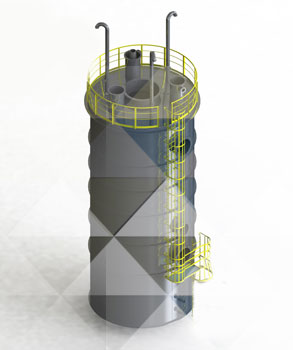Equipments
Wet-type Electrostatic Precipitator

Electrostatic Precipitators Wet are designed to eliminate liquid contaminants, such as aerosols, sulfuric acid fumes (resulting from the washing of gases containing SO3) and dust particles in general.
A rather relevant difference between this type of Precipitator and DRY Electrostatic Precipitators is that the former is easier to clean, as no hammering is required for wet precipitators because the precipitation of the retained material formed by gas fumes (forming a liquid phase) naturally occurs downward due to the action of gravity, which drags the solid particles in suspension.
In specific cases where deposits of particulate matter may be formed on electrodes, special liquid spray nozzles can be considered, increasing the wet phase and reducing the amount of solids.
The design of this sort of equipment usually contemplates a cylindrical shape in horizontal position, with the flexibility for the gas intake to be placed either at the top or bottom thereof. However, a rectangular shape may be used for special cases. The underlying principle is ionization of suspended particles by electrodes, followed by the capture of such particles by an electric field generated from high voltage rates.
Serial equipment can be used for increased capture capacity, and so can other layouts, depending on the space available at the customer’s. Irrespective of the type of process, all Electrostatic Precipitators - Wet are fitted with liquid spraying systems that work intermittently.
Such equipment can be manufactured with simpler materials, such as carbon steel or high-tech materials to prevent corrosion, which is one of the main problems with treated gases for any equipment. Such more sophisticated models are better suited for treating gases resulting from calcinations for production of Titanium Dioxide (TiO2), sulfuric acid production processes where sulfur dioxide (SO2) is used, and dry washing of gases from incineration and chemical processes.
The condensate matter is extracted and sent off to the appropriate transportation or packaging process or, where necessary, reinserted into the customer’s system following an adjustment process.


